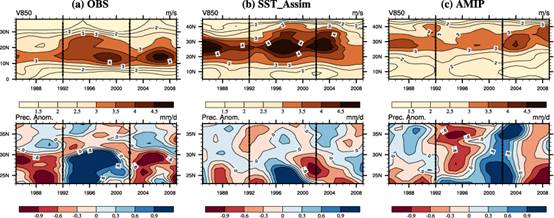Applying Ocean Data Assimilation in a Coupled Model to Improve the Simulation of the East Asian Summer Monsoon
Date:2017-01-20
In the climate modeling community, CMIP-type and AMIP-type simulations are widely adopted. In CMIP-type runs, a fully coupled general circulation model (CGCM) is integrated for several hundred model years, with external forcing (e.g., CO2, aerosols, volcanic eruptions, solar radiation) imposed. In an AMIP-type run, an atmospheric general circulation model (AGCM) is driven by prescribed SST. The merit of a CMIP-type run compared with an AMIP-type run is that it is more realistic, because the air–sea coupling process is considered. However, compared with a CMIP-type simulation, an AMIP-type simulation will suffer less climate “drift” and is driven by “real” SST, meaning AGCMs often perform better than CGCMs in many aspects. However, for the East Asian summer monsoon (EASM), simulations of both types suffer from problems, which is a great challenge for the climate modeling community to overcome.

Fig. 1. Time–latitude distribution of 7-year low-pass filtered meridional wind at 850 hPa (V850) and anomalous rainfall derived from (a) OBS, (b) SST_Assim and (c) AMIP. The V850 and rainfall anomalies are averaged over East China (110o–120oE).
In a study published recently in Advances in Atmospheric Sciences, scientists from Institute of Atmospheric Physics assimilated, using the EnOI (Ensemble Optimal Interpolation) scheme, the observed SST in an earth system model developed at the Chinese Academy of Sciences (CAS-ESM), and established a weakly coupled assimilation system[Dong et al. (2016)]. First, they evaluated the performance of the system. Then, using the system, the team conducted a successful simulation of the decadal variation of the EASM in the latest 30 years (Lin et al. 2016). It was found that the changes of the EASM’s circulation as well as its associated rainfall could be reproduced well (Fig. 1).
Dr. Renping LIN, one of the authors, concluded that the key factors leading to this success story include "Through assimilation of the 'real' SST, the internal signal of the climate system (e.g., ENSO) could be incorporated into the coupled model; The air–sea coupling process was considered in the system, because a coupled model was used rather than an AGCM alone. "
References
Lin, R., J. Zhu, and F. Zheng, 2016: Decadal shifts of East Asian summer monsoon in a climate model free of explicit GHGs and aerosols. Sci. Rep., 6, 38546, doi: 10.1038/srep38546.
Dong X., and Coauthors, 2016: Evaluation of ocean data assimilation in CAS-ESM-C: Constraining the SST field. Adv. Atmos. Sci., 33(7), 795–807, doi:10.1007/s00376-016-5234-8.
Contact: LIN Renping, linrenping@mail.iap.ac.cn
